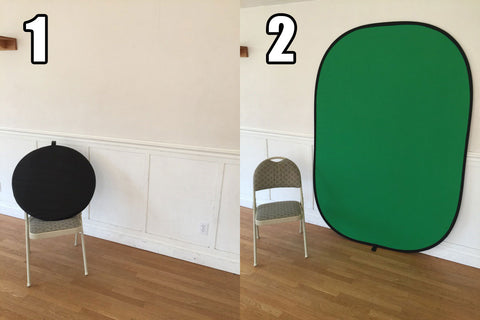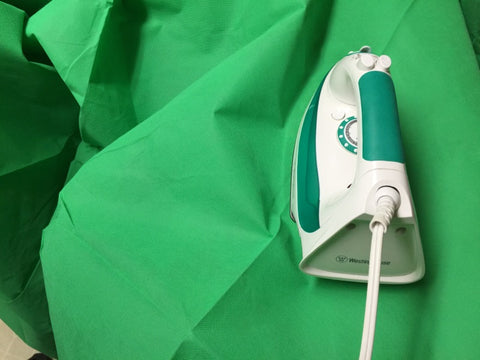Chroma-Keying for Stop Motion Animation: Choosing & Lighting Your Screen
Posted by Nate Eckerson on
There are many kinds of chroma key screens available. You can buy chroma key fabric, collapsible pop-up screens, or simple sheets of poster board.
Poster Board
Since you typically don't need a lot of screen material for stop motion sets, green and blue poster board can be the cheapest and easiest material to use. Here we've attached a piece to a microphone stand with a clothespin. You can also stand it up on your animation table, or tape it to a wall. Make sure that the color is a rich colorful blue or green, not light blue or turquoise.
Chroma Key Fabric
If you buy green screen fabric, you'll probably need to run an iron over it before use, since wrinkles will produce shadows, which effect the quality of your key.
In this picture we're using two microphone stands with a piece of pipe between them as a hanger (we're a big fan of microphone stands around here. They're cheap and can be used as stands for pretty much anything, if it's not too heavy). The picture was taken before ironing, so you can see there's a lot of wrinkles!

A plus of using fabric is that you can cut it into smaller sizes if you need to. It can also be stretched out and taped to a wall, which minimizes wrinkling.
Chroma Key Pop-Up Panel

Another option to consider are pop-up or collapsable "panel" screens. These are big sheets of chroma-key fabric encircled by a springy frame, which — when unfolded — expand to 5' x 7' feet or more! Some come with blue on the front, and green on the back, which is super handy.
The only downside of panels is the size — 5' x 7' can be a bit big for most animation spaces, and these things take practice to fold up properly! However the size can be a plus if you don't have a stand to hang material from, you can simply lean the panel against a wall and animate in front of it.
Misc Chroma Key Materials
For specialty applications you can buy green and blue chroma-key paint. This picture was taken behind a warehouse where a TV show was being shot. The film crew painted the whole wall green and filmed their scenes in front of it.

Green and blue tape is also available, if you need to cover small areas up.
Lighting Your Screen
Set your screen some distance behind the animation set. As mentioned previously, you'll want to make sure that the surface is free of wrinkles and other blemishes which may show up as imperfections in the key. Small issues will be hidden if your camera & lens setup has a low depth of field, blurring out the background. The frame below is a good example of this.

It is not difficult to light a scene for chroma keying, as long as you are using at least two light sources, one for the foreground, and another for the screen itself. This controls shadows, and ensures that the key color is showing clearly.
It's important to not light the screen too brightly, as this can cause colored light to "spill" onto the subject in the foreground. Also avoid "hot spots" of light which create washed out areas on the screen. Both problems can be solved by pointing the background light at the screen indirectly, or diffusing the light by shining it through a semi-opaque material.

Here you can see a light underneath our table shining it up at the screen. It isn't diffused, and a large hot spot has appeared. Since we're running LED bulbs which don't generate heat, we used a frosted plastic bag to fix the light. DO NOT USE THIS MATERIAL if you're running hot incandescent lights! The plastic will melt and you'll burn your studio down. A bad day for everyone.
Finally, for all our chroma-keying tests, we used daylight-temperature LED bulbs, which are shifted towards the blue end of the color spectrum, versus indoor-temperature bulbs, which are more orange. You may achieve better results with daylight bulbs, because they will not shift the color of your chroma-key screen.
In the next post, see how different cameras and software compare when using green screens vs blue screens!



